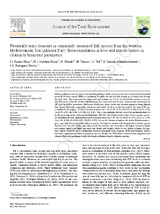Mostrar el registro sencillo del ítem
Potentially toxic elements in commonly consumed fish species from the western Mediterranean Sea (Almería Bay): Bioaccumulation in liver and muscle tissues in relation to biometric parameters
| dc.contributor.author | Ramos-Miras, José Joaquín | |
| dc.contributor.author | Sánchez-Muros, M.J. | |
| dc.contributor.author | Morote, E. | |
| dc.contributor.author | Torrijos, M. | |
| dc.contributor.author | Gil, Carlos | |
| dc.contributor.author | Zamani-Ahmadmahmoodi, R. | |
| dc.contributor.author | Rodríguez- Martín, José A. | |
| dc.date.accessioned | 2024-01-25T07:43:50Z | |
| dc.date.available | 2024-01-25T07:43:50Z | |
| dc.date.issued | 2019 | |
| dc.identifier.isbn | 0048-9797 | |
| dc.identifier.uri | http://hdl.handle.net/10396/26746 | |
| dc.description.abstract | Marine pollution is one of today's most relevant problems. Public awareness has been raised about the harmful potential of heavy metals (HMs) accumulating in edible fish and possibly ending up in human diet through the food chain. This study aimed to characterize and evaluate As, Cd, Cr, Cu, Ni and Pb contents in four edible fish species from the western Mediterranean Sea. Liver and muscle toxic elements were determined by GF-AAS in Mullus surmuletus, Merluccius merluccius, Auxis rochei and Scomber japonicus from Almería Bay (Spain). Muscular composition, biometrics and trophic levels were also determined. The mean PTE concentration levels (mg kg−1, DW) in fish muscle tissue were: As (2.90–53.74), Cd (0.01–0.18), Cr (0.53–2.01), Cu (0.78–6.93), Ni (0.06–0.24), Pb (0.0–0.32). These concentrations did not exceed the maximum limits set by European legislation (Commission Regulation (EC) No. 1881/2006) for the intake of these marine species. Accumulation of toxic elements tends to be seen in the liver (As (7.31–26.77), Cd (0.11–8.59), Cr (0.21–2.94), Cu (2.64–16.90), Ni (0.16–1.03), Pb (0.0–0.99)). As was the element at highest risk in this Mediterranean region, especially due to red mullet values in muscle. The high As contents with living habits as benthic species that feed near the coast. HMs, especially muscle Cd contents, were associated with higher contents of lipids and organic matter, and bigger specimen size (length and weight), while As was linked to higher fish protein content. However, these relationships between potentially toxic elements (PTE) and biometric indices and body composition parameters depend on species. Finally, the THQ indices indicated that eating fish from Almería Bay poses no human health risk despite pollution from the Almería coastline. | es_ES |
| dc.format.mimetype | application/pdf | es_ES |
| dc.language.iso | eng | es_ES |
| dc.publisher | Elsevier | es_ES |
| dc.rights | https://creativecommons.org/licenses/by-nc-nd/4.0/ | es_ES |
| dc.source | Ramos-Miras, J., Sánchez‐Muros, M. J., Morote, E., Torrijos, M., Gil, C., Zamani‐Ahmadmahmoodi, R., & Rodríguez-Martín, J. A. (2019). Potentially toxic elements in commonly consumed fish species from the Western Mediterranean Sea (Almería Bay): bioaccumulation in liver and muscle tissues in relation to biometric parameters. Science of The Total Environment, 671, 280-287. https://doi.org/10.1016/j.scitotenv.2019.03.359 | es_ES |
| dc.subject | Heavy metals | es_ES |
| dc.subject | Mediterranean seafood | es_ES |
| dc.subject | Fish biometrics | es_ES |
| dc.subject | Food safety | es_ES |
| dc.subject | Trophic relationship | es_ES |
| dc.title | Potentially toxic elements in commonly consumed fish species from the western Mediterranean Sea (Almería Bay): Bioaccumulation in liver and muscle tissues in relation to biometric parameters | es_ES |
| dc.type | info:eu-repo/semantics/article | es_ES |
| dc.relation.publisherversion | https://doi.org/10.1016/j.scitotenv.2019.03.359 | es_ES |
| dc.relation.projectID | Gobierno de España. CGL2013-43675-P | es_ES |
| dc.rights.accessRights | info:eu-repo/semantics/openAccess | es_ES |

